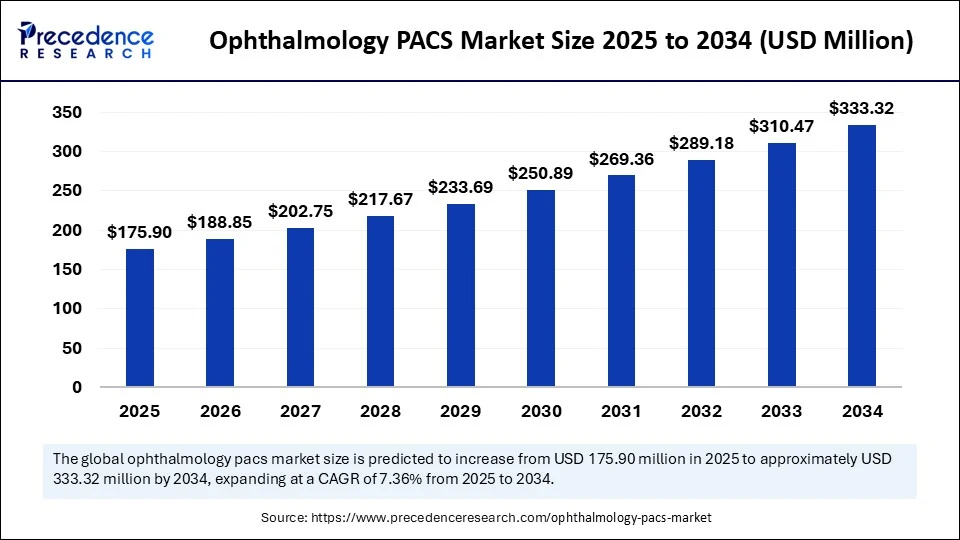The global ophthalmology Picture Archiving and Communication System (PACS) market is projected to increase from USD 175.90 million in 2025 to USD 333.32 million by 2034, expanding at a CAGR of 7.36% during the forecast period. The market was valued at USD 163.84 million in 2024.
The accelerated growth of the ophthalmology PACS industry is attributed to the rising incidence of vision-related disorders, increasing demand for digital healthcare solutions, smooth integration with electronic health records (EHRs), and the growing importance of artificial intelligence (AI) in diagnostic imaging. Aging populations worldwide, coupled with the surge in teleophthalmology and remote consultations, are further strengthening the demand for advanced PACS platforms tailored for ophthalmology.
Read Also : Behavioral Health Market
Quick Insights
-
Market Valuation (2024): USD 163.84 million
-
Market Forecast (2034): USD 333.32 million
-
CAGR (2025–2034): 7.36%
-
Top Region (2024): North America with 49% market share
-
Fastest Growing Region: Asia Pacific
-
Leading Component (2024): Software with 55% share
-
Deployment Mode (2024): Cloud-based PACS captured 48% share
-
Key End User (2024): Hospitals with 50% revenue contribution
-
Top Imaging Modality (2024): Optical Coherence Tomography (35% share)
-
Major Companies: Carl Zeiss Meditec, Topcon, Heidelberg Engineering, Siemens Healthineers, Canon Medical, IBM Watson Health, Agfa-Gevaert Group, Carestream Health, NIDEK Co., Ltd.
Market Revenue Outlook (USD Million)
| Year | Market Size (USD Million) |
|---|---|
| 2024 | 163.84 |
| 2025 | 175.90 |
| 2034 | 333.32 |
What Opportunities Are Driving the Ophthalmology PACS Market?
The market is being shaped by several high-impact opportunities:
-
AI-Powered Diagnostics – Artificial intelligence is transforming ophthalmology PACS by automating tasks like image annotation, segmentation, and anomaly detection. AI integration is enhancing early-stage detection of retinal detachment, macular degeneration, and diabetic retinopathy, paving the way for personalized treatment strategies.
-
Teleophthalmology Expansion – The rapid adoption of telemedicine has increased the need for scalable, cloud-based PACS solutions. Remote consultations, enabled by PACS integration, improve access to eye care in underserved and rural regions, creating significant growth opportunities.
-
Shift Toward Digital Healthcare – The transition from traditional film-based systems to digital solutions is accelerating. PACS platforms streamline workflows, enable data-driven decision-making, and align with the global trend toward EHR integration and interoperable health IT ecosystems.
-
Government and Institutional Support – Public initiatives, including the U.S. Vision Health Initiative (VHI) and digital health programs in China, India, and Germany, are fueling adoption of PACS by subsidizing infrastructure and incentivizing early diagnosis.
Regional Analysis
North America – Market Leader
North America accounted for 47% of the global market in 2024, led by the U.S., which recorded USD 45.88 million in market size. Favorable reimbursement policies, government initiatives like the Vision Health Initiative, and high adoption of AI-driven diagnostics contribute to the region’s dominance. By 2034, the U.S. ophthalmology PACS market is expected to reach USD 95.17 million.
Asia Pacific – Fastest Growing
Asia Pacific is projected to register the fastest CAGR through 2034, driven by rapidly expanding healthcare infrastructure and investments in digital health. Countries such as China, India, Japan, and South Korea are key growth hubs. China, in particular, benefits from government-led investments in smart healthcare technologies, addressing rising cases of myopia and diabetic retinopathy.
Europe – Strong Growth Potential
Europe remains a robust growth region, driven by preventative eye care initiatives, stringent regulatory frameworks, and advanced healthcare infrastructure. Germany is a significant contributor, with widespread adoption of PACS solutions to support early diagnostics in an aging population.
Segmentation Highlights
-
Component: Software led the market in 2024 with 61% share, while services are projected to show substantial growth due to rising needs for training, integration, and maintenance.
-
Deployment Mode: On-premises solutions held 44.2% share in 2024, but cloud-based PACS is growing at a CAGR of 10.8%, fueled by scalability and teleophthalmology adoption.
-
End User: Hospitals contributed 50% revenue share in 2024, while specialty clinics and ambulatory surgical centers (ASCs) are expected to expand rapidly.
-
Imaging Modality: OCT dominated with 35% share in 2024, while fundus photography is projected to grow at the highest CAGR due to its role in retinal disease monitoring.
-
Functionality: Image storage & retrieval accounted for 40% share in 2024, while EHR integration and AI-assisted diagnostics are expected to drive future adoption.
Latest Breakthroughs and Innovations
-
InsiteOne (June 2024): Expanded its PACS portfolio with the acquisition of BRIT Systems, securing six new RIS/PACS customer contracts.
-
INFINITT (February 2024): Launched a browser-based ophthalmology PACS with an HTML5 viewer, eliminating the need for workstation downloads.
-
Novarad (January 2023): Released CryptoChart Lite, a free web-based image-sharing solution for developing countries, improving accessibility.
These innovations underscore the market’s shift toward cloud-native, browser-based, and AI-enabled solutions.
Challenges and Cost Pressures
Despite strong growth prospects, the market faces significant hurdles:
-
High Implementation Costs: Advanced PACS systems require substantial investment in hardware, secure storage, and integration, limiting adoption among smaller clinics and providers in developing economies.
-
Data Security and Compliance: As PACS integrates with cloud and telehealth platforms, ensuring compliance with HIPAA, GDPR, and other regional data privacy laws becomes a critical challenge.
-
Workforce Training: The adoption of AI and advanced imaging workflows necessitates continuous upskilling for ophthalmologists and IT staff, which may slow implementation.
Case Example – AI in Retinal Disease Detection
In clinical settings, AI-enabled PACS platforms are already demonstrating measurable impact. Hospitals using AI-driven OCT analysis have reported improved accuracy in early detection of diabetic retinopathy, reducing misdiagnosis rates and enabling more personalized treatment plans. Such real-world examples highlight how AI integration within PACS is transitioning from experimental to mainstream adoption.
For inquiries regarding discounts, bulk purchases, or customization requests, please contact us at sales@precedenceresearch.com
- Rifaximin Market Size to Hit USD 5.09 Billion by 2034 - August 29, 2025
- Ophthalmology PACS Market to Reach USD 333.32 Million by 2034 - August 29, 2025
- Behavioral Health Market to Surpass USD 330.35 Billion by 2034 - August 26, 2025

